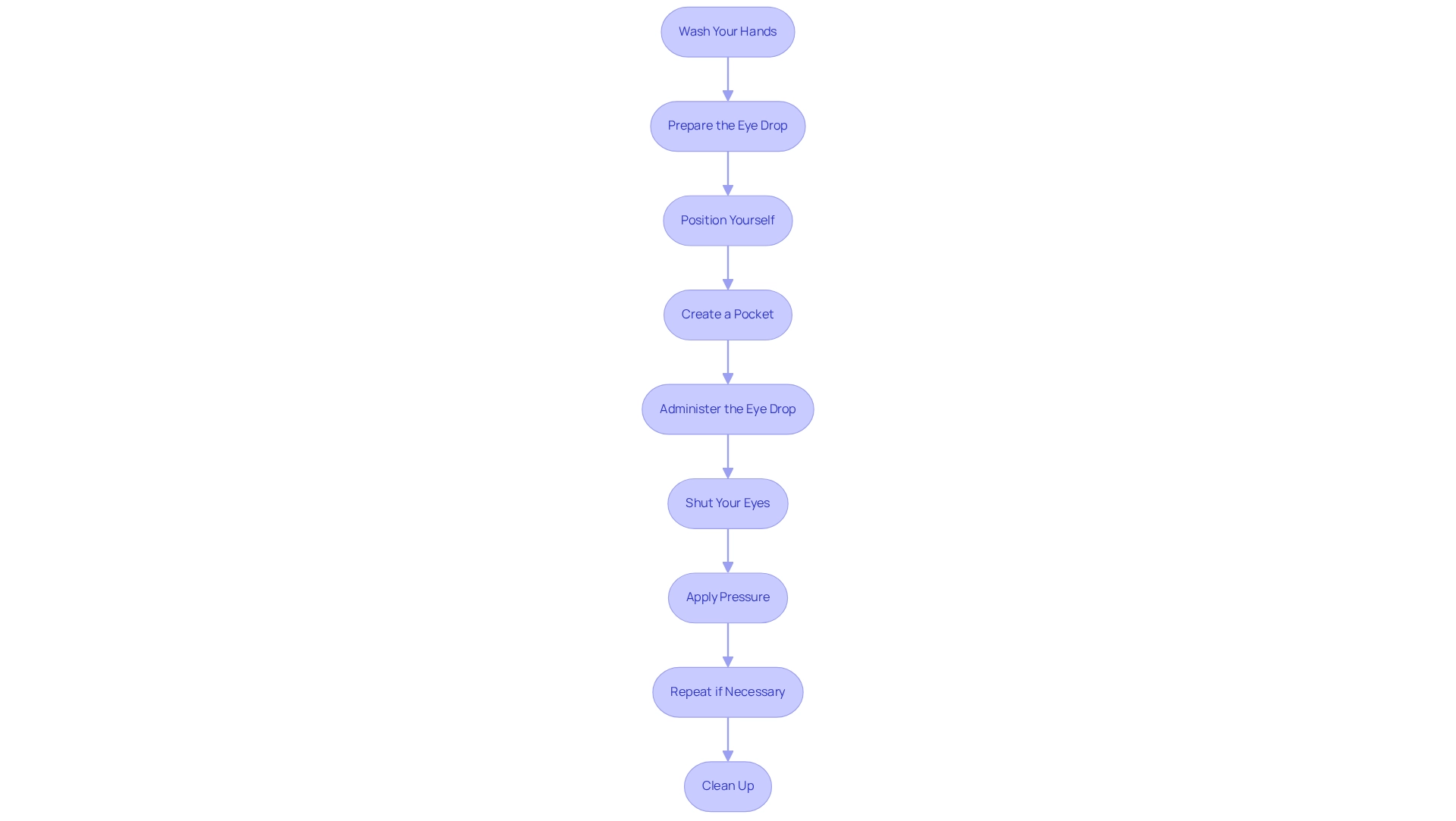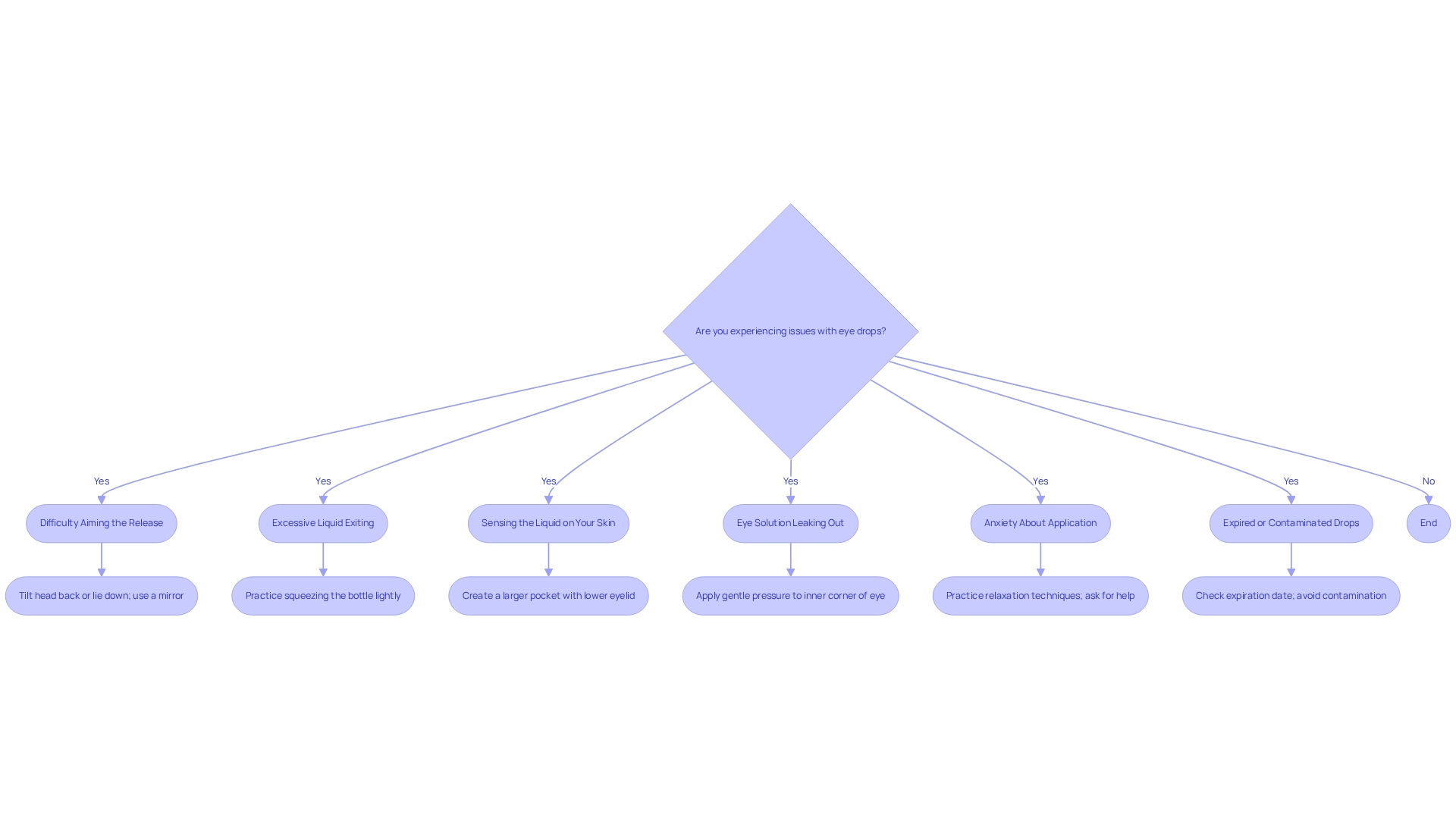Posted by: Northwest Eye in General on June 10, 2025
Overview
This article is here to guide you through the essential steps for successfully applying eye drops. We understand that the process can feel daunting, but focusing on the right technique and maintaining hygiene are crucial for effective treatment. Our step-by-step guide will help you feel more confident in your approach.
- Start by washing your hands thoroughly. This simple act is vital for preventing infections.
- Next, create a pocket in your lower eyelid. This technique allows for better absorption of the drops.
- Applying gentle pressure can further enhance this process.
Research shows that proper application techniques significantly improve outcomes for conditions like dry eye disease.
We are here to help you through this process, ensuring you feel supported every step of the way. Remember, it’s common to have questions or concerns, and we encourage you to reach out for assistance if needed.
Introduction
In the realm of eye care, we understand that navigating the various types of eye drops and their specific applications can feel overwhelming. It’s crucial for maintaining optimal eye health, and knowing that you’re not alone in this journey can provide some comfort. From lubricating drops that soothe dryness to antibiotic solutions that combat infections, each category serves a unique purpose in addressing common ocular issues.
However, the act of applying these drops can often come with its own set of challenges. It’s common to have questions about proper techniques and how to troubleshoot frequent problems. This article aims to delve into the essential knowledge surrounding eye drops, offering step-by-step instructions for effective application along with solutions to the issues you might face. By enhancing your awareness and skills in eye drop usage, we hope to empower you to significantly improve your treatment outcomes and overall eye comfort. Remember, we are here to help you through this process.
Understand Eye Drops: Purpose and Types
Eye drops are liquid medications specifically formulated for direct application to the eye, and they can be categorized based on their intended purpose:
- : Often referred to as artificial tears, these solutions are intended to relieve dryness and irritation by imitating the composition of natural tears. They are particularly beneficial for individuals suffering from dry eye syndrome, a condition that affects a significant portion of the population. It’s common to feel discomfort, and studies indicate that nearly 50% of adults experience some form of dry eye symptoms.
- Antihistamine Solutions: These solutions are effective in alleviating allergy symptoms, such as redness and itching caused by allergens. We understand that allergy seasons can be challenging, but real-world instances show that antihistamine eye drops can significantly alleviate discomfort, offering rapid relief for those impacted.
- Antibiotic Solution: Prescribed for bacterial infections, this solution is essential for eliminating harmful bacteria in the eye. We want you to feel reassured that this treatment helps prevent complications and promotes healing.
- Glaucoma Medications: These treatments are vital for controlling glaucoma by reducing intraocular pressure. Maintaining vision is important, and we are here to support you in managing this condition effectively.
- Steroid Solutions: Frequently recommended after surgery or for inflammatory eye issues, steroid solutions assist in decreasing inflammation and enhancing recovery. It’s common to feel uncertain during recovery, but these solutions play a crucial role in your healing process.
Comprehending the particular kind of eye drop you are using is crucial for adhering to the appropriate application technique and dosage as instructed by your healthcare provider. Recent research emphasizes the efficacy of lubricating eye solutions in alleviating dry eye symptoms, especially when paired with lifestyle changes, like the 20-20-20 guideline for screen usage. We encourage you to remember that patient education is key in managing chronic eye conditions effectively. We are here to help you through this process.
Apply Eye Drops: Step-by-Step Instructions
To apply eye drops effectively, we want to guide you through with care:
- Wash Your Hands: Begin by thoroughly washing your hands with soap and water. This simple act helps prevent contamination and ensures your safety.
- Prepare the eye drop by checking the expiration date on the bottle and gently shaking it if needed. Remove the cap without touching the dropper tip to maintain cleanliness.
- Position Yourself: Sit or stand comfortably. Tilt your head back slightly and look up at the ceiling, allowing for easier application.
- Create a Pocket: With one hand, use your index finger to pull down your lower eyelid, forming a small pocket. This will help the drops stay in place.
- Administer the eye drop: Hold the dropper above your eye, aiming for the pocket you created. Squeeze the bottle softly to release a single bead into the pocket, ensuring the dropper tip does not contact your eye or eyelid, which can be uncomfortable.
- Shut Your Eyes: After applying the solution, gently close your eyes for a moment without blinking or pressing them shut. This allows the eye drop to settle.
- Apply Pressure: To prevent the liquid from draining into your throat, apply gentle pressure to the inner corner of your eye (tear duct) for about one minute. We understand that this may feel a bit unusual, but it’s important for effectiveness.
- Repeat if Necessary: If more applications are needed, wait at least 5 minutes before administering the next dose. This gives your body time to absorb the medication.
- Clean Up: Wipe away any excess liquid from your face with a clean tissue and securely replace the cap on the eye medication bottle.
Following these steps can significantly improve your adherence to using eye drops for treatment. Research shows that proper application techniques lead to better outcomes, especially for those managing conditions like dry eye disease (DED). By creating ocular solutions with reduced application frequencies, we can enhance compliance, emphasizing the importance of considering your lifestyle in treatment strategies. Remember, we are here to help you through this process.

Troubleshoot Common Eye Drop Issues
We understand that using an eye drop can sometimes be challenging. Here are some common issues you may encounter, along with practical solutions to help you feel more at ease:
- Difficulty Aiming the Release: If you find it hard to aim the release accurately, try tilting your head back further or lying down. Using a mirror can also be beneficial in guiding your aim.
- Excessive Liquid Exiting: If you notice that several drops exit simultaneously, gently squeeze the bottle and ensure you are not holding it too close to your eye. Practice squeezing the bottle lightly to find the right touch.
- Sensing the Liquid on Your Skin: If the liquid lands on your skin instead of your eye, consider creating a larger pocket with your lower eyelid or adjusting your angle slightly.
- Eye Solution Leaking Out: If the liquid runs out of your eye, applying gentle pressure to the inner corner of your eye after application can help keep the medication in place.
- Anxiety About Application: It’s common to feel anxious about applying eye solutions. Consider practicing relaxation techniques, such as deep breathing, before you attempt to administer them. If it helps, ask a family member or friend to assist you during the process.
- Expired or Contaminated Drops: Always check the expiration date before use, and avoid touching the dropper tip to any surfaces to prevent contamination. If you suspect contamination, please discard the bottle and consult your healthcare provider for a replacement.
Statistics show that 85.5% of individuals understand that eye solutions have a limited shelf-life after being opened, emphasizing the importance of proper storage and usage. Furthermore, studies indicate that many patients demonstrate , highlighting the need for targeted education to enhance application methods. As one researcher noted, ‘Our results are typically aligned with earlier studies demonstrating inadequate eye instillation methods in specific populations.’ By addressing these common issues and implementing the suggested solutions, you can enhance your experience with eye drop application and ensure effective treatment. Remember, eye medications are for single-patient use only and should not be shared to prevent contamination. We are here to help you through this process.

Conclusion
Understanding the various types of eye drops and their specific applications is essential for maintaining optimal eye health. We recognize that navigating this information can feel overwhelming, but this article has outlined the key categories of eye drops—from lubricating and antihistamine drops to antibiotics and glaucoma medications—emphasizing their unique purposes in treating common ocular issues. Knowing the right type of drop to use is the first step towards effective treatment, and we are here to help you through this process.
The step-by-step instructions provided for applying eye drops highlight the importance of proper technique to enhance your confidence and improve treatment outcomes. It’s common to feel uncertain about how to administer eye drops, but by following these guidelines, you can ensure that you are doing so correctly, reducing the likelihood of common application problems.
Addressing potential issues that may arise during the application process is equally crucial. We understand that challenges such as aiming the drop accurately or managing anxiety about the application can be daunting. The troubleshooting tips discussed can help mitigate these difficulties. With awareness and practice, you can overcome these challenges, leading to a more comfortable and effective experience with your eye medications.
In summary, empowering yourself with knowledge about eye drops, their application, and troubleshooting techniques can significantly improve your eye comfort and treatment efficacy. By taking these steps, you can navigate your eye care journey with confidence, ultimately achieving better eye health outcomes. Remember, we are here to support you every step of the way.
Frequently Asked Questions
What are eye drops and their purpose?
Eye drops are liquid medications formulated for direct application to the eye, serving various purposes such as relieving dryness, alleviating allergy symptoms, treating infections, managing glaucoma, and reducing inflammation.
What are lubricating eye solutions?
Lubricating eye solutions, also known as artificial tears, are designed to relieve dryness and irritation by mimicking the composition of natural tears. They are particularly beneficial for individuals with dry eye syndrome.
Who can benefit from lubricating eye solutions?
Individuals suffering from dry eye syndrome can benefit from lubricating eye solutions, as studies indicate that nearly 50% of adults experience some form of dry eye symptoms.
What are antihistamine eye drops used for?
Antihistamine eye drops are effective in alleviating allergy symptoms, such as redness and itching caused by allergens, providing rapid relief during allergy seasons.
When are antibiotic eye drops prescribed?
Antibiotic eye drops are prescribed for bacterial infections to eliminate harmful bacteria in the eye, helping to prevent complications and promote healing.
How do glaucoma medications work?
Glaucoma medications are vital for controlling glaucoma by reducing intraocular pressure, which is essential for maintaining vision.
What is the purpose of steroid eye drops?
Steroid eye drops are recommended after surgery or for inflammatory eye issues to decrease inflammation and enhance recovery.
Why is it important to understand the type of eye drop being used?
Understanding the specific type of eye drop is crucial for adhering to the appropriate application technique and dosage as instructed by a healthcare provider.
How can lubricating eye solutions be more effective?
Recent research emphasizes that lubricating eye solutions can be more effective in alleviating dry eye symptoms when paired with lifestyle changes, such as following the 20-20-20 guideline for screen usage.
What role does patient education play in managing chronic eye conditions?
Patient education is key in effectively managing chronic eye conditions, and healthcare providers are available to support patients through the process.






